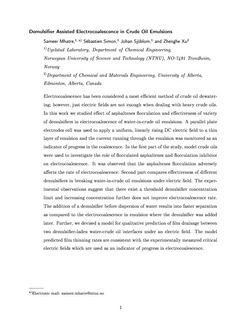| dc.contributor.author | Mhatre, Sameer | |
| dc.contributor.author | Simon, Sebastien Charles | |
| dc.contributor.author | Sjøblom, Johan | |
| dc.contributor.author | Xu, Zhenghe | |
| dc.date.accessioned | 2018-05-04T09:14:28Z | |
| dc.date.available | 2018-05-04T09:14:28Z | |
| dc.date.created | 2018-05-02T16:35:23Z | |
| dc.date.issued | 2018 | |
| dc.identifier.citation | Chemical engineering research & design. 2018, 134 117-129. | nb_NO |
| dc.identifier.issn | 0263-8762 | |
| dc.identifier.uri | http://hdl.handle.net/11250/2497126 | |
| dc.description.abstract | Electrocoalescence has been considered a most efficient method of crude oil dewatering; however, just electric fields are not enough when dealing with heavy crude oils. In this workwe studied effect of asphaltene flocculation and effectiveness of variety of chemical demul-sifiers in electrocoalescence of water-in-crude oil emulsions. A parallel plate electrode cell was used to apply linearly rising uniform DC electric field to a thin layer of emulsion and the current running through the emulsion was monitored as an indicator of progress in thecoalescence. In the first part of the study, model crude oils were used to investigate the roles of flocculated asphaltenes and flocculation inhibitor in electrocoalescence process. It was observed that the asphaltene flocculation adversely affects the rate of electrocoalescence. Second part compares effectiveness of different chemical demulsifiers in breaking water-in-crude oil emulsions under electric field. The experimental observations suggest that there exist a threshold demulsifier concentration limit and further increasing the concentration does not improve electrocoalescence rate. Also the addition of a demulsifier before dispersion of water results into faster separation as compared to the electrocoalescence inemulsion where the demulsifier was added later. Further, we devised a model for qualitative prediction of film drainage between two demulsifier-laden water–crude oil interfaces undera constant DC electric field. The film thinning rates predicted by the model are consistent with the experimentally measured critical electric field values. | nb_NO |
| dc.language.iso | eng | nb_NO |
| dc.publisher | Elsevier | nb_NO |
| dc.relation.uri | https://www.sciencedirect.com/science/article/pii/S0263876218301758?via%3Dihub | |
| dc.title | Demulsifier assisted film thinning and coalescence in crude oil emulsions under DC electric fields | nb_NO |
| dc.type | Journal article | nb_NO |
| dc.description.version | submittedVersion | nb_NO |
| dc.subject.nsi | VDP::Kjemi: 440 | nb_NO |
| dc.subject.nsi | VDP::Chemistry: 440 | nb_NO |
| dc.source.pagenumber | 117-129 | nb_NO |
| dc.source.volume | 134 | nb_NO |
| dc.source.journal | Chemical engineering research & design | nb_NO |
| dc.identifier.doi | https://doi.org/10.1016/j.cherd.2018.04.001 | |
| dc.identifier.cristin | 1582981 | |
| dc.relation.project | Norges forskningsråd: 255174 | nb_NO |
| dc.description.localcode | This is a submitted manuscript of an article published by Elsevier Ltd in Chemical Engineering Research and Design, 10 April 2018 | nb_NO |
| cristin.unitcode | 194,66,30,0 | |
| cristin.unitname | Institutt for kjemisk prosessteknologi | |
| cristin.ispublished | true | |
| cristin.fulltext | original | |
| cristin.fulltext | preprint | |
| cristin.qualitycode | 1 | |
